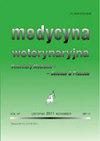利用血液分析预测过渡期奶牛亚临床低钙血症的特点
IF 0.4
4区 农林科学
Q4 VETERINARY SCIENCES
Medycyna Weterynaryjna-Veterinary Medicine-Science and Practice
Pub Date : 2022-01-01
DOI:10.21521/mw.6607
引用次数: 1
摘要
本研究旨在介绍奶牛在过渡时期亚临床低钙血症的特点,并利用血液分析预测。我们检测了116头产多产荷斯坦奶牛从妊娠第2周到产后第14天血浆钙(Ca)、磷(P)、骨代谢标志物ⅰ型胶原蛋白羧基末端末端肽(CTX)、成纤维细胞生长因子(FGF23)、1,25(OH)2D3、甲状旁腺激素和其他血液生化分析的波动。血浆Ca 0浓度被认为是产犊后亚临床低钙血症风险增加的指示。评分规则准确率为79.3%,灵敏度为76.9%,特异性为81.3%。血浆FGF23、CTX和Ca浓度是奶牛产后亚临床低钙血症的理想预测指标。本文章由计算机程序翻译,如有差异,请以英文原文为准。
Characteristics and prediction of subclinical hypocalcemia in dairy cows during the transition period using blood analytes
This study aimed to present the characteristics of and to predict subclinical hypocalcemia in dairy cows during the transition period using blood analytes. We examined fluctuations in plasma calcium (Ca), phosphorus (P), bone metabolic markers carboxy-terminal telopeptide of type I collagen (CTX), fibroblast growth factor (FGF23), 1,25(OH)2D3, parathyroid hormone, and other blood biochemical analytes from prepartum week 2 to postpartum day 14 in 116 multiparous high-producing Holstein cows from a free-stall barn dairy farm. With a plasma concentration of Ca <2.0 mmol/L as a criterion for the diagnosis of subclinical hypocalcemia, 64 cows were classified as normocalcemic, and 52 cows as subclinically hypocalcemic. Among the 52 hypocalcemic cows, 50 were detected on postpartum days 1 or 3, and 2 on postpartum day. The subclinically hypocalcemic cows were in a state of low bone turnover in the prepartum period, with low plasma concentrations of Ca and CTX. The subclinically hypocalcemic cows showed signs of a P regulation disorder in the prepartum period. This was marked by high plasma concentrations of P and low concentrations of 1,25(OH)2D3 and FGF23, which is also considered to be the cause of the low bone turnover. The results of a multiple logistic regression model showed that prepartum plasma concentrations of FGF23, CTX, and Ca were ideal predictors of postpartum subclinical hypocalcemia in dairy cows, using the model equation 38.8-0.052*FGF23-0.492*CTX-10.645*Ca, with a score of > 0 considered as an indication of increased risk of subclinical hypocalcemia after calving. The scoring rule had an accuracy of 79.3%, sensitivity of 76.9%, and specificity of 81.3%. The plasma concentrations of FGF23, CTX, and Ca were ideal predictors of postpartum subclinical hypocalcemia in dairy cows.
求助全文
通过发布文献求助,成功后即可免费获取论文全文。
去求助
来源期刊

Medycyna Weterynaryjna-Veterinary Medicine-Science and Practice
VETERINARY SCIENCES-
CiteScore
0.80
自引率
0.00%
发文量
73
审稿时长
4-8 weeks
期刊介绍:
"Medycyna Weterynaryjna" publishes various types of articles which are grouped in the following editorial categories: reviews, original studies, scientific and professional problems, the history of veterinary medicine, posthumous memoirs, as well as chronicles that briefly relate scientific advances and developments in the veterinary profession and medicine. The most important are the first two categories, which are published with short summaries in English. Moreover, from 2001 the editors of "Medycyna Weterynaryjna", bearing in mind market demands, has also started publishing entire works in English. Since 2008 the periodical has appeared in an electronic version. The following are available in this version: summaries of studies published from 1999 to 2005, full versions of all the studies published in the years 2006-2011 (in pdf files), and full versions of the English studies published in the current year (pdf). Only summaries of the remaining studies from the current year are available. In accordance with the principles accepted by the editors, the full versions of these texts will not be made available until next year.
All articles are evaluated twice by leading Polish scientists and professionals before they are considered for publication. For years now "Medycyna Weterynaryjna" has maintained a high standard thanks to this system. The review articles are actually succinct monographs dealing with specific scientific and professional problems that are based on the most recent findings. Original works have a particular value, since they present research carried out in Polish and international scientific centers.
 求助内容:
求助内容: 应助结果提醒方式:
应助结果提醒方式:


